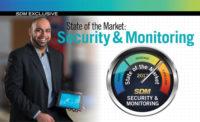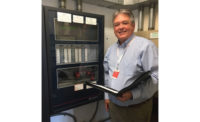2018 Outlook and Beyond
At all levels of the market, from manufacturer to dealer, integrator and central station, the outlook for 2018 remains positive.
“We’re optimistic about 2018,” Chiavacci says. “The economy is healthy, construction and housing starts continue their upward trend. The security industry is also expected to realize continued growth, which leads us to believe more homeowners will adopt security and smart home systems this year.”
Elder expects a continued high level of security spending in 2018. “We see the demand the country is making for video to protect infrastructure; we see law enforcement stretched so far they are mandating video verification. The amount of dollars spent in 2018 will be unprecedented like I have never seen in my career. As a central station I have positioned my company to be on the front end of that so we can provide an outstanding level of experience, whether it is a high level government client or grandma hitting that PERS button.”
Things are changing, Rao-Russell says, but that doesn’t have to be a bad thing. “If you were good at it, it shouldn’t change what you are doing, only the way you are presenting it. Things are becoming more and more consultative. The days of someone taking your word for it because you have a security logo are over. You have to show and provide value.”
One other thing the industry has going for it, Rao-Russell says, is its collective attitude. “I am more optimistic. There has been a lot of innovation this year and a lot of acceptance within the industry of things like SaaS and video verification and new and different models. We are no longer using the ostrich method where we have our head in the sand. … We have an industry of maverick entrepreneurs who have built these amazing family businesses. As I am seeing attitudes change and openness to new ideas and new services, I feel as an industry we are much stronger.”
Integration — and RMR — Is a State of Mind
For many security dealers, learning to think like an integrator is becoming increasingly necessary to function in the current state of both residential and commercial security. Conversely, security integrators have to get their minds around the RMR model. This is leading to more and more blurring of the lines — particularly at the SMB end of the commercial market, where residential dealers are dipping their toes into that market and cloud-based SaaS solutions are most prevalent.
“There is not a real set distinction of what makes you an integrator over an alarm dealer,” says J. Matthew Ladd, The Protection Bureau. “We are integrating everything, so that means we are taking multiple devices that used to run by themselves and now run together. I sell a burglar alarm and integrate cameras over Z-Wave. Guess what: I am now an integrator.”
What has traditionally separated integrators from dealers is the RMR component, says NAPCO’s Jorge Hevia. “Integrators never really lived on RMR. Now you have a lot of access control cloud-driven products that are RMR generators,” he says.
“To survive in this industry these days you have to explore different avenues,” says Howard Fischman, Knight-Watch Security Systems. “I consider us an integrator. Most places we go into, it is very rare we just do a burglar alarm. There is always something else involved.”
This is a trend that is just going to continue, adds Joey Rao-Russell, Kimberlite Corp. “Our sweet spot is medium to large commercial, which has always needed integration. But thanks to technology catching up to the things that we used to kind of have to force it to do, that traditional dealer that was going to sell a kit and keypad doesn’t have as much place in the market. They are providing a better service for that out of Home Depot. MSOs can do that and give you a slick app. Both on the residential and commercial side, the way we think of dealers will change within the next two to five years.”
The learning curve is not all on the dealer’s side, however, she adds. “On the integrator side we sold these massive solutions, trained the people, then left. Nobody just wants you to put in a card reader anymore. They want to see analytics — where are my hot spots? Use RFID to see how long people are standing in place. … The dealer has to learn the solution side, but they have to learn the services side. How does an integrator know how to provide service to somebody for 10 years? They are used to turning a profit on the sale. The only thing that makes money is RMR. Our P&L is insane. It looks crazy [on the books] but the margin is there. It is hard to wrap your head around until you have the economy of scale.”
For both sides, Tom Echols, president and general manager, Security 101-Global, West Palm Beach, Fla., recommends focusing on process, not product. “That is what drives value to our customers and provides standards and scalability for electronic security.”
The ‘Age’-Old Problem
For integrators, dealers and manufacturers across the industry, the No. 1 challenge they face is hiring good people — particularly younger workers. When asked what the biggest challenges for the next year would be, 30 percent of SDM Industry Forecast respondents answered “finding/retaining employees” up from 18 percent last year and just 8 percent the year before that. Clearly this is a fast-growing concern.
“As far as threats we are only limited by the brain power of the Type A player we can attract,” says Steven Paley of Rapid Security Solutions. “The talent pool of highly qualified techs and salespeople is really my concern. … Young people today don’t say ‘I want to go into the electronic security industry when I grow up,’ and that is a problem.”
As Rao-Russell puts it, the security industry has an age issue. “Our median age is ticking up. We need the 20-somethings that are innovating and are passionate and energetic and who get us in order to grab those millennials, because they aren’t going to want to buy from their grandpa.”
The problem, she says, is that security isn’t “sexy” enough. “Wouldn’t you rather work on a game algorithm for Google? I don’t blame them, but there has to be a way as an industry we can put some of our resources and capital towards talking about how we get the next generation. How do we get them passionate and intrigued enough to stay?”
Will Tax Breaks Drive Sales?
On Dec. 22, 2017, President Trump signed into law H.R. 1, the Tax Cuts and Jobs Act, P.L. 115-97, which implements tax reform to lower the after-tax cost of security and fire protection systems for small- and medium-sized businesses. The Tax Cuts and Jobs Act also doubled the amount that a business can claim in a tax year under Section 179 to $1 million. The question is, how much will it actually drive business?
Since it is brand new, there is much to be seen and watched over the coming year about its impact. But while industry organizations such as SIA laud the provision for security and fire, dealers and integrators believe its actual impact may be more limited.
“Tax reform is nice to have,” says Steven Paley, Rapid Security Solutions. “Our clients that have security and asset protection needs and goals, those are what are driving the decision. Tax strategies are nice, but at our level they are certainly not driving business.”
Howard Fischman, Knight-Watch Security Systems, describes the tax provision as a nice thing with potential to help. “If they allow taking that all at once, I could definitely see that helping,” he says.
Joey Rao-Russell of Kimberlite Corp. also believes it will help for certain sectors, but it all depends on the customer. “It’s a nice buzzword if you are talking to a CFO and can tell them they might be able to get a tax break on it. But what I see on the front lines is it is only one arrow in the quiver.”
Rao-Russell says it is critical to know what matters most to your customer. Maybe it is the tax break, or maybe it is something else. “Someone that tax break is important to, that will matter. But if they have just had a loss and they want to know how you are going to solve their pain, it may not. Do I think it will be a singular driving force? Probably not.”
Sunsetting Sunsets?
One of the issues many dealers faced in 2016 was the sunsetting of 2G, which officially ended January 1, 2017, although there were stragglers for several months. While 2017 was technically an “off” year, 3G could sunset as soon as 2019.
Green field customers were not affected by this, but dealers with a large base of existing customers had to spend a good percentage of time going back and retrofitting those systems, while trying to upsell them, instead of getting new customers.
“It takes resources and time to do that,” says Joey Rao-Russel of Kimberlite Corp. “I would love to put sales staff on nothing more than growing new business, but I have to use them for maintaining our business. There is a balance between retention and growth.”
And while she says they do upsell the customer on a new service, it is less than a brand new customer. “If they are already at $50 a month in monitoring, you might get $10-$20 more per month for an interactive [account]. We have to spend the same amount of effort to get that $10 as we would to get $70-$80 for a new customer.”
And while the recent sunset is still fresh in everyone’s memory, the pain of going through that may not be galvanizing them to start the next one as soon as they should. “You have to transition them now, or in the next 12 months so you are not deploying capital that will be useless in a year,” says Xfinity’s Daniel Herscovici. “There is some urgency. The ROI for this is often at least two years, meaning that by the end of 2018, if I am not putting next generation hardware in my next customer’s home, I now have to touch that customer again before they become profitable for me.”
Manufacturers of cellular and other communications devices are working to make the next sunsets and beyond less onerous for dealers. For example, Telular has rolled out a new line of LTE alarm communicators with universal downloading, which allows dealers to opt out of dealing with the eventual 3G sunset, says Shawn Welsh, senior vice president product line management and marketing, Telular Corp., Chicago.
“These constant technology changes from public providers continue to frustrate alarm installing companies and have opened opportunities for AES, where sunsetting becomes a thing of the past,” says Jim Burditt, vice president of sales, AES Corp., Peabody, Mass. IntelliNet 2.0, the company’s alarm communication method that doesn’t require dealers to constantly upgrade, has been updated this past year, he explains. “Our team is optimistic about the coming year as more and more alarm installers look for a communications solution that doesn’t sunset, doesn’t fully rely on public infrastructure and has become even easier to install.”
Bosch is another company trying to ease the pain of constant sunsets. “IP and cellular communication adoption is growing as dealers upgrade existing systems to replace telephone line communications,” says Paul Garms. “We will continue to support this by introducing enhancements to our B465 Universal Dual Path communicator this year.” The communicator will enable dialer-based fire or intrusion control panels to use modern IP or cellular communication formats, he says.
NAPCO’s solution for sunsets is a rebate program, which worked very well for their dealers in this past one, says Jorge Hevia. “It makes the cost of equipment more palatable to dealers and we had a surge of activations going well into March of 2017.”
Are DIY and MSOs Growing the Pie?
For years the residential security industry has sat at somewhere between 18-20 percent penetration into homes. When DIY and MSOs entered the space, many wondered, “Will they be competition, or will they help grow the pie?” This year we are starting to get some better input on which it is, and the news looks positive. Parks Associates forecasts that roughly 28 percent of broadband households will have a security system by 2018, driven in part by DIY solutions and expanding channels to market.
“A number of DIY security solutions and announcements hit the market at the end of 2017,” says Dina Abdelrazik, Parks Associates. “2018 will be a year of opportunity for DIY and a test for legacy alarm vendors who have yet to embrace the DIY movement. This market shift illustrates the biggest opportunity for the alarm business in the coming year.”
Increasingly, dealers are paying attention. Many have added DIY solutions to their toolbox, even if it is only a “when all else fails” sales tool. While DIY providers still top the list of SDM Industry Forecast respondents’ greatest competition at 29 percent, that number has ticked down by four percentage points from last year. Wireless phone providers/broadband providers stayed low at 6 percent, versus 7 percent last year.
While it is still early days, security dealers are hopeful that the influence of these new entrants, with their large advertising budgets and online presence, is in fact growing the overall market.
“Everyone despises DIY,” says Joey Rao-Russell, Kimberlite Corp. “But there are millions of dollars of revenue that moves around this industry, and up until recently we never really cracked that 20 percent mark. For the first time in five years we are seeing what looks to be an increase in market penetration. It looks like MSOs and DIY companies are moving a ton of units. If the market share of our industry was still only 20 percent, we would be showing losses, and we are not. We are showing small growth. We may not be sexy like Yahoo or Google, but nobody is losing money on security. It is logical to assume AT&T and Comcast are bringing people not traditionally our customers into our space.”
This is only going to continue, particularly with Comcast’s latest move. “At CES we announced we are giving away home automation to 15 million of our subscribers at no additional cost,” Herscovici says. The reasoning is that if customers get a taste of what home automation can do, they will ask for monitored security. “We are giving away the basics of home automation and security is an upgraded feature,” he explains.
Sharon Elder, National Monitoring Center, agrees. “Major players like Google with Nest have come into our space. They haven’t taken over the independent dealer space but rather opened up the playing field. … What started off as DIY can be recaptured in RMR if you give dealers tools to onboard it to professional monitoring. When a customer buys two Nest cams at Best Buy and you are able to say ‘I can monitor those,’ you are addressing a market you weren’t addressing before. The space is opening up with these entrants.”
What’s more, a lot of DIY products are geared toward millennial and younger consumers and the anticipation is that as these customers age they will look to professionally installed and monitored solutions to do it for them. “The analogy I use is when I was in college I had no money; I cooked everything myself, changed my own oil, did all my own laundry,” Rao-Russell says. “Then life changed and I had kids and a job and more chaos. Now I pay someone to do my dry-cleaning and I have someone change my oil. I think of DIY the same way. Eventually they won’t want to be on a ladder installing a camera themselves.”
However, she stresses, that doesn’t mean dealers don’t have to change with the times to capitalize on this. “I think we will still see competition and have to change our business models and what we do. However, these people are going to be wanting bigger, better, stronger, or good, better, best options, too. DIY is entry level. … It brings a new customer base to farm. The more people we can bring in, the more we can sell.”







